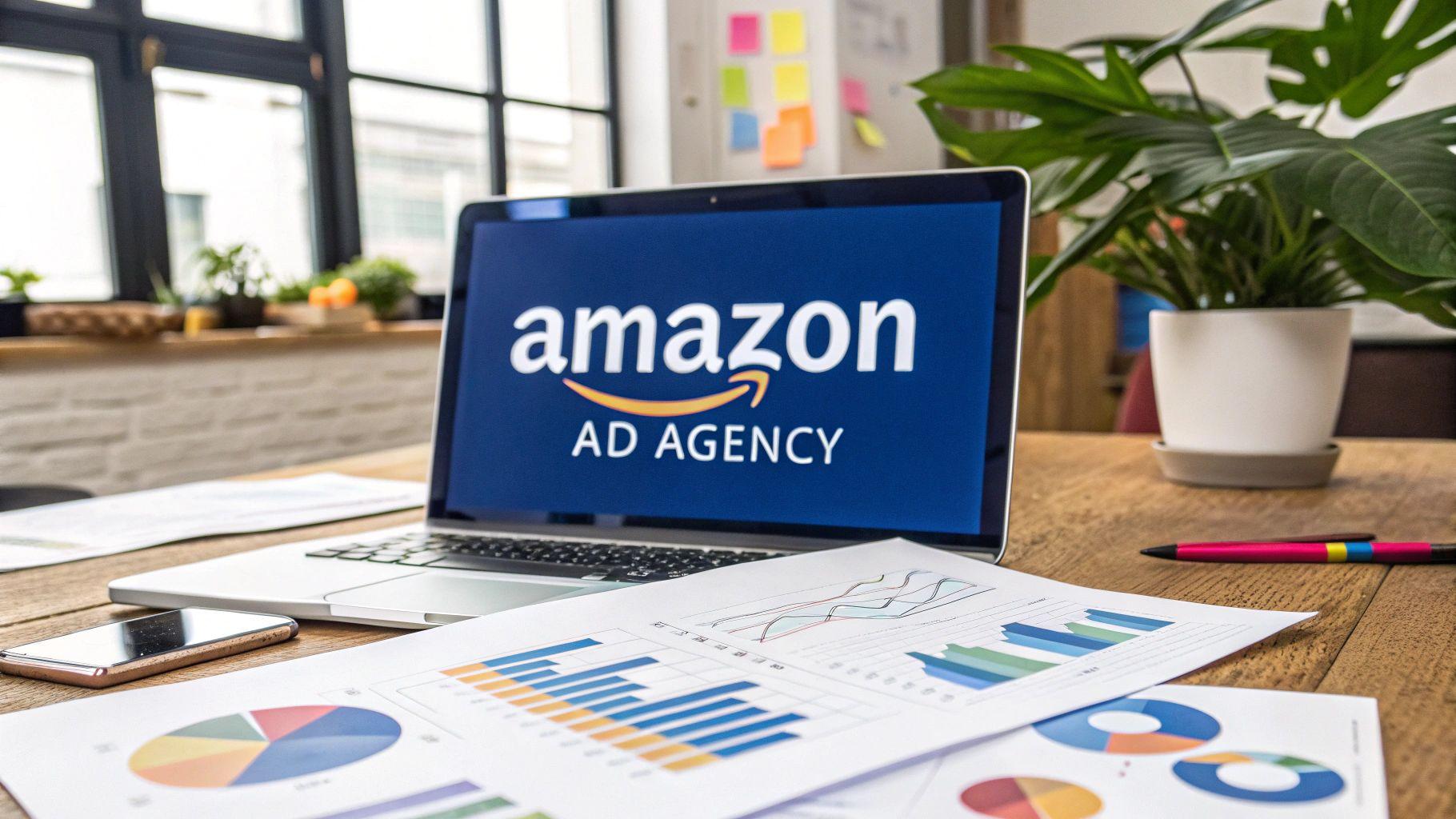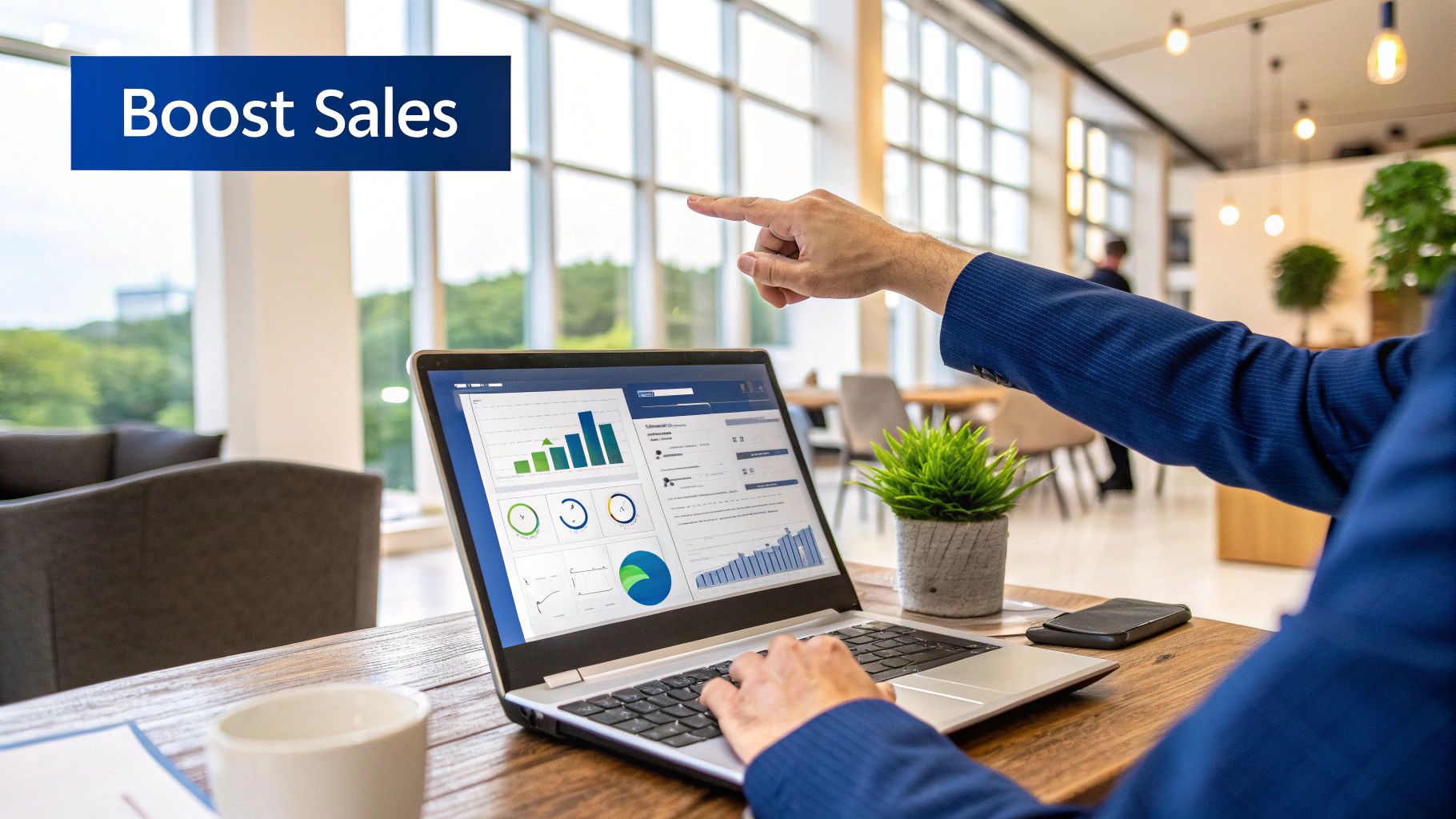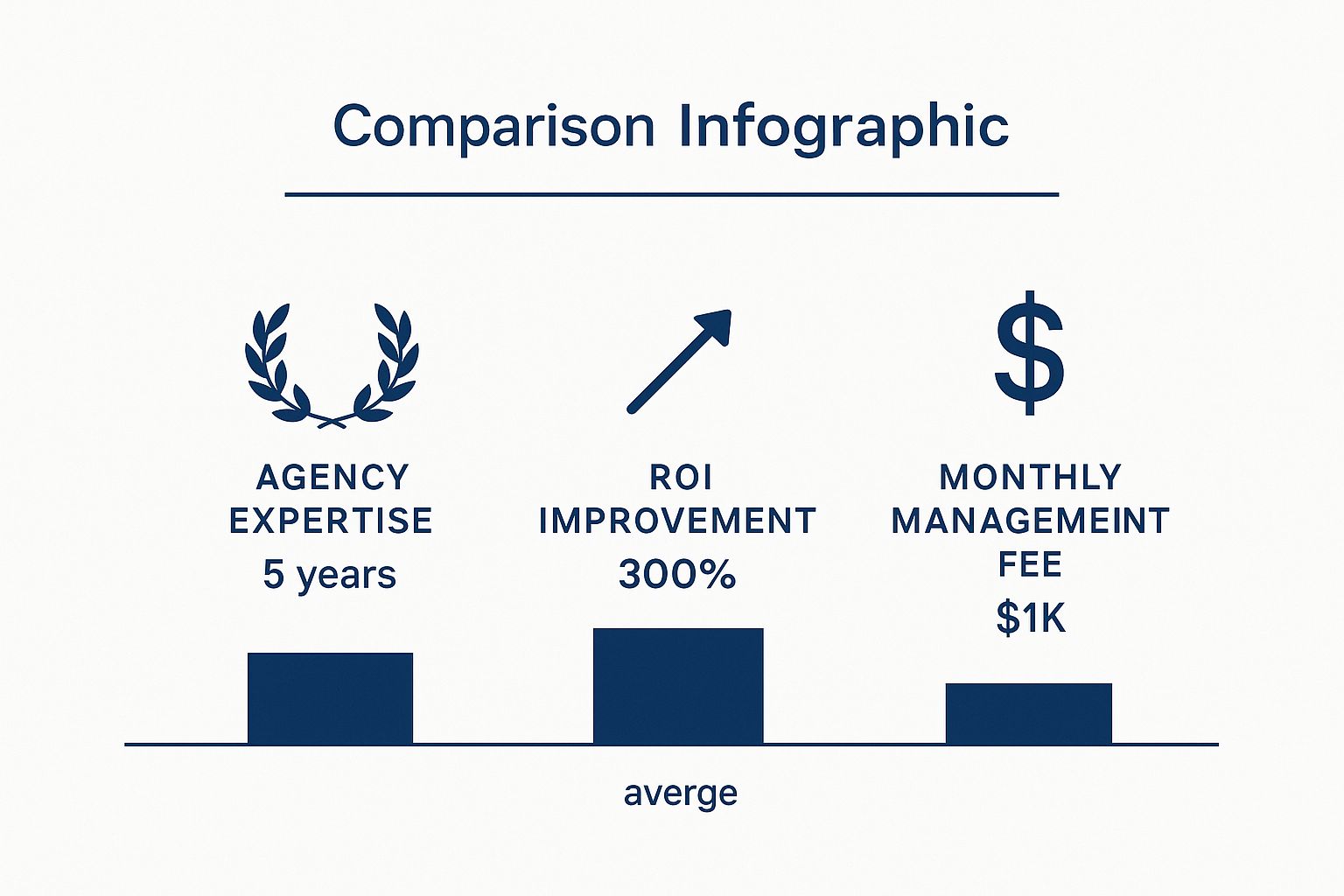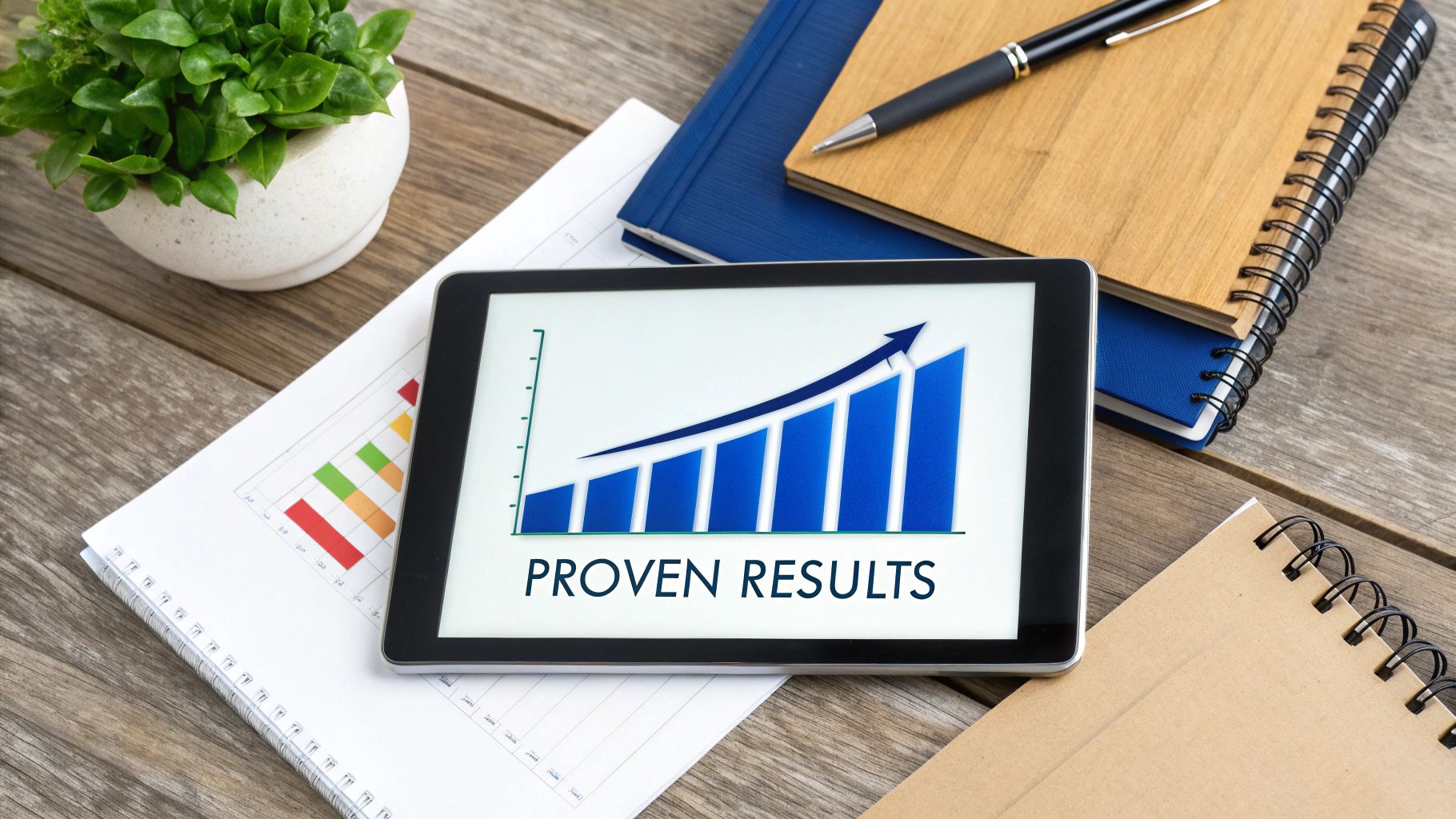Your Guide to an Amazon Advertising Agency: Profit, Performance & Growth
Find the right Amazon advertising agency to drive real growth. Our guide covers PPC, DSP, and the metrics that truly matter for scaling your brand on Amazon.

Struggling to make your Amazon ad spend drive real profit? You're not alone. A true Amazon advertising agency doesn't just manage campaigns; they act as a strategic partner, turning your PPC spend into a powerful lever for organic growth, profitability, and sustainable scale. They connect ad performance directly to your P&L, focusing on what really moves the needle for your business goals.
Why Smart Brands Partner with an Amazon Advertising Agency

Let's be direct: the Amazon marketplace is a hyper-competitive battlefield. For many eCommerce leaders, running Pay-Per-Click (PPC) campaigns in-house often leads to wasted ad spend, stalled growth, and a constant struggle against rising costs. This is where a performance-first Amazon advertising agency fundamentally changes the game.
Think of it this way: managing Amazon ads without a specialist is like trying to navigate a dense jungle without a map. You might find a path, but you'll waste valuable time and resources. An expert agency is your guide with a map built from years of experience, proprietary data, and a deep understanding of Amazon's ever-shifting algorithm.
Beyond Campaign Management to Strategic Partnership
The biggest misconception is that an agency's job is to simply tweak bids and keywords. That's table stakes. A true partner operates at a higher, strategic level, weaving your advertising efforts into the fabric of your brand’s entire Amazon ecosystem.
A top-tier agency is obsessed with the big picture. Their primary goal isn't just a low Advertising Cost of Sale (ACoS); it's achieving a low Total Advertising Cost of Sale (TACOS). This small acronym change represents a massive strategic shift. It ensures every ad dollar creates a powerful flywheel effect, where paid visibility directly fuels organic sales and ranking.
The Headline POV: A great Amazon advertising agency turns ad spend from an expense into a high-yield investment. Their work must lead to improved organic rankings, increased market share, and, most importantly, measurable profit for your business.
The Advantage of Expert Knowledge and Tools
Elite agencies bring more than just extra hands; they bring a decisive edge through deep expertise and powerful technology. Many have ex-Amazonians on staff, providing invaluable insider knowledge of how the platform actually works.
They also come equipped with sophisticated software and custom-built dashboards that reveal insights the average seller never sees. This allows them to:
- Make Data-Backed Decisions: Every adjustment is rooted in real-time data and predictive modeling, not guesswork.
- Drive Full-Funnel Growth: They masterfully blend PPC with the Demand-Side Platform (DSP) to engage customers at every stage of the buying journey.
- Build for Sustainable Scale: They create a foundation for long-term success by improving "retail readiness," optimizing product listings, and building a brand that can weather competitive pressure.
By entrusting this to a specialist Amazon advertising agency, you free up your internal team to focus on what they do best—product innovation, brand building, and core business operations, while the agency drives measurable results on the world's largest marketplace.
Decoding the Amazon Advertising Playbook: PPC vs. DSP
To scale your brand on Amazon, you must look beyond sponsoring products in search results. A seasoned Amazon advertising agency understands the platform is a full-funnel ecosystem. The two most powerful tools are Pay-Per-Click (PPC) and the Demand-Side Platform (DSP). Not understanding their distinct roles is one of the most expensive strategic errors a brand can make.
Think of it like fishing. PPC is spear-fishing in a river full of active hunters—you're targeting high-intent shoppers right in front of you. DSP is like casting a massive net across the ocean to capture new audiences. Both are incredibly effective, but only when used for the right purpose at the right time.
PPC: The Frontline for Capturing Active Demand
PPC, also known as Sponsored Ads, is your primary tool for shoppers who are actively hunting. It targets users based on keywords they type into the Amazon search bar, putting your product in front of them at the exact moment of high intent. When someone searches "noise-canceling headphones," your sponsored ad appears, timed perfectly to capture that bottom-of-funnel click.
This makes PPC essential for driving sales from customers ready to buy. It’s a direct-response mechanism built for immediate conversion. Mastering PPC isn't optional; it's the foundation of your entire advertising structure. For a deeper dive, our guide on what is Amazon PPC covers how to nail these foundational campaigns.
DSP: The Engine for Building Audiences and Retargeting
Amazon's DSP is an entirely different strategic play, designed for top- and mid-funnel marketing. Instead of targeting keywords, DSP targets audiences based on shopping behaviors, demographics, and lifestyle interests. It allows you to run display and video ads not just on Amazon, but across its vast media network, including:
- Prime Video and Twitch
- IMDb and Fire TV
- Thousands of third-party websites and apps in Amazon's network
The reach is immense. DSP is how you introduce your brand to new customers before they’ve even searched for you. It's also your primary tool for retargeting shoppers who viewed your product but didn't convert, bringing them back to complete their purchase.
The image below gives you a glimpse of the kind of results a skilled agency can pull off by mastering these tools.

As you can see, partnering with an agency that truly knows its stuff can lead to big improvements in your return on investment, often for a very reasonable fee.
To make the distinction crystal clear, here’s a quick rundown of how these two powerful platforms stack up against each other.
Amazon PPC vs. DSP At a Glance
| Attribute | Amazon PPC (Sponsored Ads) | Amazon DSP (Demand-Side Platform) |
|---|---|---|
| Primary Goal | Drive immediate sales, capture high-intent demand. | Build brand awareness, reach new audiences, and retarget past visitors. |
| Targeting | Keywords and products. Targets active shoppers on Amazon. | Audiences. Targets users based on demographics, lifestyle, and past purchase behavior. |
| Ad Placement | On Amazon search results pages and product detail pages. | On Amazon, plus its network (Twitch, IMDb, Fire TV) and third-party sites/apps. |
| Funnel Stage | Bottom-of-Funnel (BOFU) | Top-of-Funnel (TOFU) & Middle-of-Funnel (MOFU) |
| Best For | New product launches, capturing existing demand, direct conversions. | Brand building, remarketing, reaching customers before they search for you. |
| Access | Self-service platform available to all sellers and vendors. | Typically managed through an agency or requires a significant minimum ad spend. |
Think of PPC as your sales team, closing deals with customers ready to buy now. DSP is your marketing team, building a pipeline of future customers and keeping your brand top-of-mind.
Integrating PPC and DSP for a Full-Funnel Flywheel
The real expertise lies in integration. The best agencies don't run PPC and DSP in silos; they weave them into a seamless, closed-loop strategy where each platform makes the other more effective.
Key Takeaway: Viewing PPC and DSP as separate channels is a strategic error. A top-tier Amazon advertising agency runs them as a unified engine. Insights from PPC keyword performance inform DSP audience targeting, and new audiences discovered via DSP are then nurtured and converted with highly relevant sponsored ads.
This integrated approach is non-negotiable. Amazon’s ad revenue recently surged to $15.7 billion in a single quarter—a 22% year-over-year increase, far outpacing the company's overall growth. This explosion proves Amazon is no longer just a retailer; it's a full-funnel media platform where brands connect with shoppers everywhere from the marketplace to live sports.
A smart agency leverages this entire ecosystem. They use DSP to fill the top of your funnel with qualified prospects and then deploy surgical PPC campaigns to convert that interest into sales. This coordinated attack not only drives revenue but also sends powerful positive signals to Amazon's algorithm, improving your organic rank and building sustainable, profitable growth.
The Profitability Metrics Your Agency Should Be Tracking

Any agency can generate a report filled with vanity metrics like impressions and click-through rates. But those numbers don't answer the only question that matters to an eCommerce leader: is your ad spend actually making you money? A true performance Amazon advertising agency cuts through the noise and anchors their reporting in the metrics that reflect the real financial health of your business.
Vanity metrics may feel good, but profitability metrics build businesses. To hold your agency accountable and make informed strategic decisions, the conversation must center on these core indicators. These are the numbers that prove your advertising is an engine for growth, not just an expense.
ACoS: The Foundational Efficiency Metric
Advertising Cost of Sale (ACoS) is the most common metric in the Amazon ecosystem. It’s a direct measure of campaign efficiency, telling you what percentage of sales revenue was spent on advertising. The formula is Ad Spend ÷ Ad Revenue = ACoS.
For example, if you spend $20 on ads to generate $100 in sales from those ads, your ACoS is 20%. It’s a crucial gut check on how hard your ad dollars are working.
However, an obsessive focus on the lowest possible ACoS is a strategic trap. It often leads to overly conservative campaigns that sacrifice market share and growth opportunities. A seasoned agency understands that a higher ACoS can be a necessary investment for new product launches or aggressive competitive conquests.
TACOS: The True Measure of Growth
This is the metric that separates tactical campaign managers from strategic growth partners. Total Advertising Cost of Sale (TACOS) measures your ad spend against your total revenue—including both ad-generated sales and organic sales. The formula is Ad Spend ÷ Total Revenue = TACOS.
Why is this the ultimate KPI? Because it proves whether your advertising is creating the "flywheel effect." The strategic goal of advertising isn't just to generate a paid sale; it's to increase sales velocity, which lifts your organic ranking and drives more organic sales over time.
A falling TACOS, even if ACoS remains steady, is the clearest indicator of a successful advertising strategy. It is hard evidence that your ad investment is fueling organic growth, making your business more profitable and less dependent on paid ads for every sale.
If an agency isn't reporting on and optimizing for TACOS, they are missing the entire point of strategic Amazon advertising.
Key Metrics for a Complete Performance Picture
Beyond ACoS and TACOS, a sharp agency monitors a dashboard of KPIs to ensure a holistic, profitable strategy.
Organic Rank Improvement: This is the flywheel in action. Your agency must track how ad-driven sales are improving your organic position for high-value keywords. Moving from page three to page one for a core search term is a massive win that directly impacts your bottom line.
New-to-Brand (NTB) Customers: Available in Sponsored Brands and DSP, this metric shows what percentage of sales came from first-time buyers. A high NTB rate is a powerful indicator that your ads are expanding your customer base and capturing market share, not just selling to existing customers.
Return on Ad Spend (ROAS): ROAS is the inverse of ACoS (Ad Revenue ÷ Ad Spend) and is often more intuitive for business leaders. A 20% ACoS is equivalent to a 5x ROAS. It frames ad spend as an investment delivering a direct, quantifiable return.
Ultimately, partnering with the right Amazon advertising agency should feel like adding a data-obsessed growth strategist to your leadership team. They must connect every dollar spent to your bottom line, proving their value not with clicks, but with undeniable profit.
How Smart PPC Campaigns Fuel Your Organic Growth
One of the most powerful and misunderstood concepts on Amazon is that a smart advertising strategy is the fastest path to organic growth. Many brands mistakenly view paid and organic traffic as separate channels. On Amazon, they are intrinsically linked. Investing in strategic PPC isn't just about the immediate sale; it's about igniting a virtuous cycle of growth.
This cycle is known as the "flywheel effect." Imagine trying to spin a massive, heavy flywheel. The first push is the hardest. But with each subsequent push, it spins faster, building momentum until it seems to move on its own. A well-executed PPC campaign does precisely this for your product's visibility.
The Headline POV: Paid sales velocity is a primary signal to Amazon's A9 algorithm. When you generate sales via ads, you're proving to Amazon that your product is highly relevant for a given search term. Amazon's goal is to show customers what they are most likely to buy, so it rewards that sales history with better organic rankings.
This isn't theory; it's the fundamental mechanic of the marketplace. As your product climbs the organic search results, it gets more visibility, more clicks, and more organic sales. These additional sales further strengthen your sales history, signaling even more relevance to the algorithm and pushing your rank higher still. It's a positive feedback loop that builds a profitable, defensible position on the platform.
The Flywheel in Action: A Practical Example
Let's illustrate with a real-world scenario. You've just launched a new, high-quality yoga mat. As a new product, it's buried on page 10 for the keyword "eco-friendly yoga mat." Organically, it's invisible.
Here’s how a strategic PPC campaign gets the flywheel spinning:
- Targeted Ad Investment: You launch a focused Sponsored Products campaign targeting that exact keyword with a top-of-search placement to ensure high-intent shoppers see your product.
- Initial Sales Velocity: The ads work. You generate 10-15 sales per day directly from your paid placement. This is the crucial first push on the flywheel.
- Algorithm Recognition: Amazon's A9 algorithm sees that your yoga mat is converting well for "eco-friendly yoga mat." It rewards this performance by testing your product with a better organic position, moving you from page 10 to page 3.
- Organic Growth Begins: Now on page 3, you start generating a few organic clicks and sales. These are added to your ad-driven sales, strengthening your total sales velocity.
- Accelerated Momentum: Seeing this sustained success, Amazon gives you another boost, this time to page 1. Your organic sales explode. That initial ad investment has now generated a stream of organic revenue that far outweighs the ad cost.
This is precisely why a declining Total Advertising Cost of Sale (TACOS) is the north-star metric for any skilled agency. It’s definitive proof that ad spend is building a much larger foundation of organic revenue. To learn more about building this momentum, explore our strategies on how to increase Amazon sales.
Why This Matters in a Crowded Marketplace
Understanding this paid-to-organic relationship is critical, especially as competition intensifies. Amazon's advertising business is exploding, growing by roughly 20% year-over-year to $56.22 billion. That figure proves ads have become essential for success on the platform.
In today's pay-to-play environment, you cannot afford to wait for organic discovery. A brand that uses PPC to ignite its flywheel will consistently outperform competitors who treat ads as a reactive expense. A true expert agency doesn’t just manage bids; they orchestrate this entire flywheel, turning your ad budget into a strategic investment in long-term enterprise value.
An Actionable Checklist for Vetting Your Next Agency

Choosing the right Amazon advertising agency is a critical decision. A great partner accelerates growth; a poor one burns through your budget with little to show for it. To find a true performance-focused partner, you must move beyond the sales pitch and ask the tough, practical questions.
Use this checklist during your vetting process to gauge strategic depth, data fluency, and a genuine focus on your bottom line.
Demand a Custom Strategy, Not a Cookie-Cutter Plan
The biggest red flag is an agency pitching a one-size-fits-all package. Your brand, products, margins, and competitive landscape are unique. Your advertising strategy must be, too.
A top-tier agency begins with a deep dive into your business. They should ask about product margins, inventory health, business goals, and historical performance before ever proposing a solution.
Actionable Vetting Questions:
- "Walk me through your process for developing a custom strategy for a brand in our category."
- "How would you adapt your approach to help us achieve a specific goal, like capturing market share from our top three competitors?"
- "What specific data points do you need from us to build an initial 90-day roadmap?"
Their answers should feel like a strategic workshop, not a canned presentation. If they jump to tactics without understanding your business context, they are not a strategic partner.
Scrutinize Their Reporting and KPIs
An agency’s reporting reveals their true priorities. Be wary if their dashboards are heavy on vanity metrics (impressions, clicks) but light on profitability. A performance-first agency lives and breathes the numbers that impact your P&L.
Key Takeaway: An agency’s worth isn’t measured by how busy they look but by the profitable growth they deliver. Their reports should tell a clear story connecting ad spend to total sales and better organic ranking—not just the sales directly tied to ads.
Your conversation must revolve around TACOS (Total Advertising Cost of Sale), new-to-brand customer acquisition, and organic rank improvement.
Questions to Uncover Their True Focus:
- "How do you measure and report on the impact of PPC on our organic sales?" A great agency will immediately discuss TACOS and the flywheel effect.
- "Can you share a sanitized example of a client performance report?" Look for clarity, actionable insights, and a focus on business outcomes, not just data dumps.
- "How do you incorporate new-to-brand metrics into your strategic decision-making?" This uncovers if they think like brand builders or just campaign managers.
Verify Their Full-Funnel Expertise
Many agencies are competent at running Sponsored Products campaigns but lack deep expertise in Amazon DSP. In today's market, you need a partner who can manage the entire customer journey—from building top-of-funnel awareness with DSP to converting bottom-of-funnel demand with PPC.
Ask pointed questions about their integrated approach.
- "Provide a specific example of how you used insights from a DSP campaign to inform a PPC strategy, or vice-versa."
- "What is your team's experience with Amazon Marketing Cloud for advanced attribution and audience analysis?"
The ability to create a seamless feedback loop between DSP and PPC is the hallmark of a sophisticated Amazon advertising agency. As Amazon's ad revenues soar past $60 billion, full-funnel mastery is no longer a luxury—it's a requirement for winning.
For a more exhaustive list of questions, our complete guide on how to choose an Amazon PPC advertising agency provides the tools to help you find a partner capable of delivering sustainable growth.
Turning Your Ad Spend into a Strategic Investment
For too long, eCommerce leaders have viewed their Amazon advertising line item as a cost of doing business. This mindset is the single biggest constraint holding most brands back. A modern, performance-driven Amazon advertising agency operates from a completely different premise: every ad dollar is a direct investment in the long-term enterprise value of your brand.
This is more than a semantic shift; it's a fundamental strategic re-alignment. It means moving beyond simplistic metrics like ACoS and measuring success by the KPIs that build a durable, profitable business on the Amazon platform.
Connecting Your Ad Budget to Real Business Growth
A true agency partner makes this connection tangible. They don't just tweak bids; they build a comprehensive growth plan where paid media is used systematically to drive organic sales and long-term profitability.
When executed correctly, the results are clear and measurable:
- Increased Market Share: Strategic advertising allows you to dominate "digital shelf space," displacing competitors on critical search and product pages.
- Improved Organic Rankings: The sales velocity from PPC campaigns signals relevance to Amazon's A9 algorithm, pushing your products higher in organic results.
- Sustainable Profitability: As organic sales grow, your reliance on paid advertising decreases, leading to a healthier TACOS (Total Advertising Cost of Sale) and a stronger bottom line.
This creates a powerful flywheel where the initial investment in advertising pays dividends long after the campaign ends. It’s the difference between renting traffic and owning your brand's position on the platform.
The Headline POV: The ultimate goal is to make your brand less dependent on advertising for every sale. A top-tier agency uses ads as a catalyst to build a powerful organic sales engine. Your ad budget becomes a tool for creating long-term brand equity, not just short-term revenue.
If your current ad strategy—or agency—isn't delivering these outcomes, it's time to demand more. The right Amazon advertising agency doesn't just manage your spend; they multiply its impact, transforming it from a cost center into your most powerful engine for growth.
Frequently Asked Questions
Considering an Amazon advertising agency? As an eCommerce leader, you need no-nonsense answers. Here are the most common questions we hear from brands ready to scale.
What’s a Realistic Budget for an Amazon Advertising Agency?
There is no single magic number; a realistic budget depends on your category's competitiveness, product margins, and growth objectives. As a practical starting point, a performance-focused agency often recommends allocating around 10% of your projected Amazon revenue to ad spend. This figure is typically determined after analyzing your unit economics and the average cost-per-click (CPC) in your niche.
However, the strategy is more important than the initial budget. A smart agency proves its value first. They will propose a pilot program on a select group of high-potential products, demonstrate a positive return, and then build the case for scaling the investment.
How Long Until We See Results from Amazon Advertising?
While you will see initial data like clicks and impressions within hours, the business-critical results take more time to materialize.
You should expect to see leading indicators—positive trends in campaign efficiency and sales velocity—within the first 30-60 days. This is the critical data collection and optimization phase.
The Headline POV: The true proof of performance emerges after 90 days. This is the typical timeframe required to see a meaningful impact on your Total ACoS (TACOS) and organic rank. It allows the Amazon "flywheel effect" enough time to gain momentum and demonstrably lift your organic sales baseline.
Should One Agency Manage Both Our PPC and DSP Campaigns?
Yes, absolutely. A unified management structure for PPC and DSP is essential for a cohesive, full-funnel strategy. When a single expert team handles both, insights flow seamlessly between them, eliminating data silos and budgetary inefficiencies.
Here’s the practical benefit:
- High-converting keywords discovered in PPC campaigns are used to build hyper-relevant audiences for DSP targeting.
- New audiences generated through DSP are then retargeted with surgical Sponsored Products ads to drive conversion.
Splitting these functions between different teams inevitably leads to disjointed strategies and missed opportunities. An agency with integrated, in-house expertise in both is a clear sign of strategic maturity.
What Is the Difference Between ACoS and TACOS?
This distinction is critical for any eCommerce leader. ACoS (Advertising Cost of Sale) measures campaign-level efficiency. It is your ad spend divided by the revenue generated directly from those ads.
TACOS (Total Advertising Cost of Sale) provides the holistic, business-level view. It is your ad spend divided by your total Amazon revenue, which includes both ad-driven and organic sales.
TACOS is the ultimate metric for brand growth. A declining TACOS is the definitive proof that your advertising investment is successfully boosting your organic sales—the key to building a profitable, sustainable, and scalable brand on Amazon.
Ready to turn your Amazon ad spend from a cost center into a strategic growth driver? The experts at Headline Marketing Agency specialize in data-driven PPC and DSP strategies that deliver measurable profitability and market share. Partner with us to unlock your brand's true potential on Amazon.
Wollen Sie Ihre Amazon PPC-Performance aufs nächste Level bringen?
Lassen Sie Ihre Amazon PPC-Kampagnen professionell analysieren und entdecken Sie neue Wachstumsmöglichkeiten.